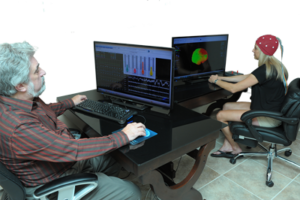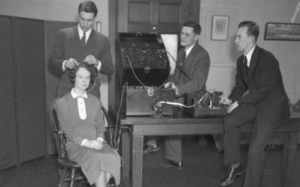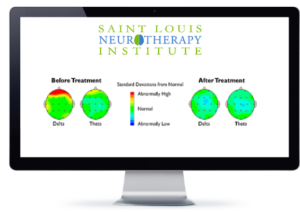Neurofeedback therapy— also known as neurotherapy or biofeedback— is the process of retraining the brain to produce slower brain waves in people suffering from a large variety of conditions such as ADHD, anxiety, migraines etc. Brain waves determine behavior and mood, and through neurofeedback, patients learn to “quiet” their minds on demand by slowing down their brain waves. This is achieved by reinforcing positive changes in brain wave activity thus creating more permanent connections in the brain.

Neurofeedback has a long history, some say going back as far as 100 years, beginning as an area of study for many neurologists, physiologists, psychiatrists, and scientists. Electroencephalography (EEG), and Quantitative EEG (QEEG) was not truly popularized until the 1960’s. In this 1935 picture, a physician attaches components of an early electroencephotograph machine to a woman's head.

The mainstream medical community in Europe has been utilizing biofeedback as a treatment option for decades, however it’s been slower to gain popularity in the US.
A QEEG brain map allows biofeedback practitioners to see the areas of a client’s brain where there is too much or too little activity, and areas where the brain is not communicating with other areas of the brain as best it could, resulting in undesired behaviours or feelings. These areas become the target of the biofeedback training. A post-training QEEG brain map can show the changes to the patterns of activity as a result of the neurotherapy.

Neurofeedback uses sensors to painlessly determine the existing brain waves and create a map of what needs to change in order to create the desired state. Through neurofeedback training, permanent changes can be made to the connections in the brain, making it easier and easier to bring the brain waves to that state, reducing, or eliminating the unwanted symptoms. Medication, on the other hand, especially for conditions such as ADHD only provides symptom relief while the medication is being taken. Once medication stops, those symptoms come back.
Many patients start neurofeedback therapy while taking their existing medications. Medication can be reduced once positive changes have been seen from the neurotherapy, but only under the advice of a medical professional.
Neurofeedback training will work at different rates for different people. It largely depends on the severity of the brain activity that is being changed. Some will find it easier than others to change brain waves on demand, and will therefore require less training sessions. We usually like our patients to conduct the training 4-5 times a week, for 40 minutes each time.
Typically, due to brain development and plasticity, younger patients require less sessions to achieve the same results than an older patient. In some cases, the patient may not feel like there has been much change, but those close to them have noticed differences. The changes can be very subtle in the beginning, but as training progresses and the patient builds strength, the changes will be much more noticeable as the brain moves more towards the desired state.
We recommend you continue with the brain training for several sessions after you’ve noticed consistent and reliable improvement, rather than stopping as soon as you seen the desired results. This will help to reinforce the new brain patterns even more, and ensure it becomes habit.
As mentioned above, we like our patients to conduct the training 4-5 times a week. For this reason we provide patients with the equipment and training needed to conduct the neurotherapy treatment in the comfort of their own home. At the end of the training, we ask that patients come in to the clinic to retest the new brainwave patterns to confirm treatment effectiveness.
Unlike medication, biofeedback therapy creates a permanent retraining of the brain for that particular symptom. Neurofeedback also known as Neurotherapy training can be continued on a regular basis for clients who wish to maintain optimal brain functioning.
No. While St. Louis Neurotherapy and Brain Balance both help children (and adults at St Louis Neurotherapy) who struggle behaviorally, socially, and academically with conditions such as ADHD and Anxiety. St. Louis Neurotherapy differs in that we focus on changing the electrical activity in the brain while using a protocol approved by the American Pediatric Association and using only FDA approved equipment. Brain Balance does not measure any form of brain activity. It also has no scientific evidence for the efficacy of its methods other than client surveys, nor does it use FDA approved equipment.

